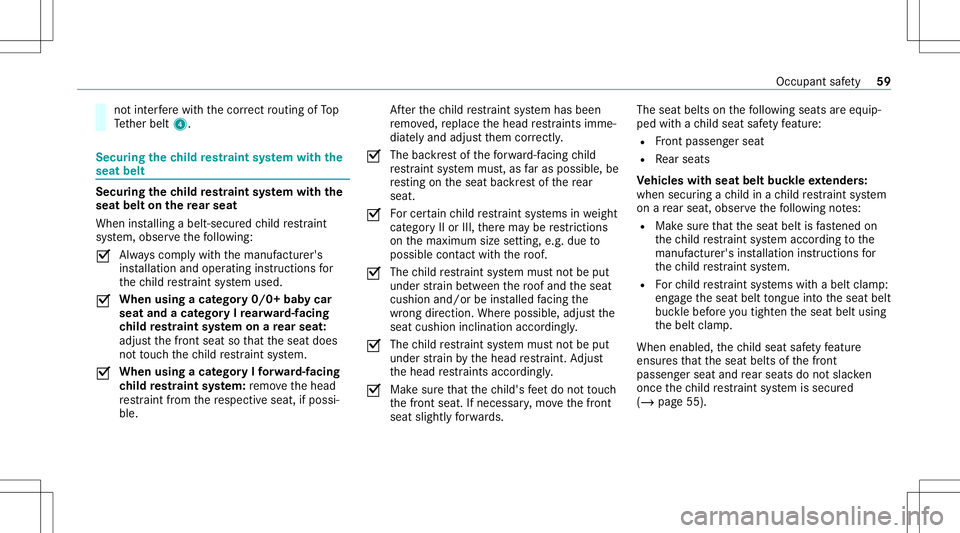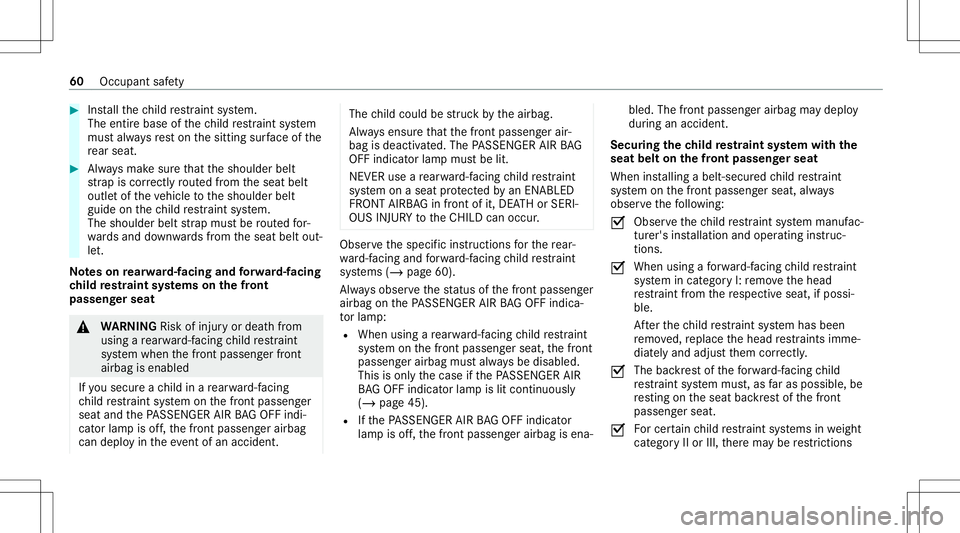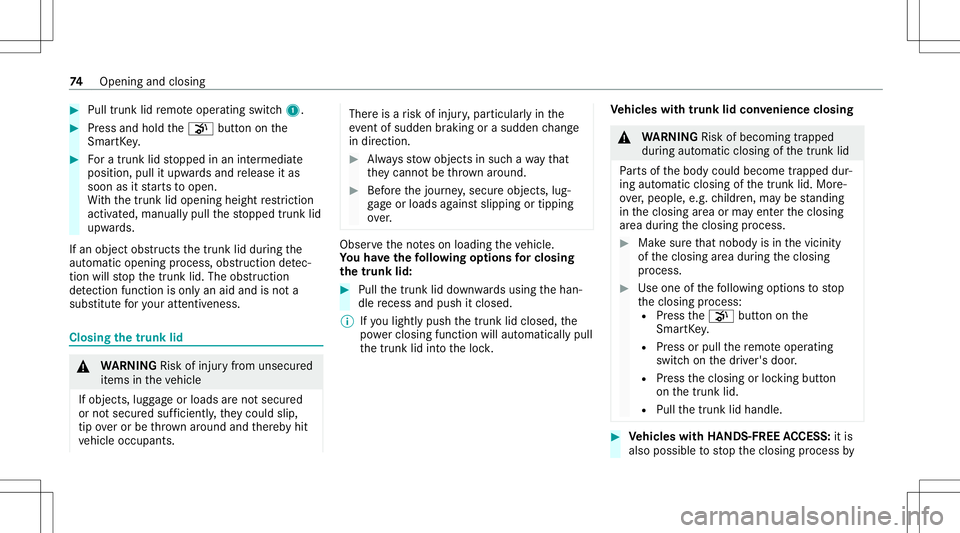2020 MERCEDES-BENZ S-CLASS ECU
[x] Cancel search: ECUPage 59 of 602

Bef
oree very jour ney,mak esuret hat theL ATCH -
type (ISOFIX )child restra int system iseng aged
cor rectl yinb othm ounting brac kets inthev ehi‐
cle. *
NO
TEBecarefu lnot to damag ethe seat
belt fort he cent erseat when installing
th ec hild restra int system #
Mak esuret hat thes eat belt isno ttrap‐
ped. #
Vehicl eswith reclining rear seats: Tilt th e
re cli ning rear seat backres tb acks ligh tly
bef oret he LATC H-type (ISOFIX )child
re stra int system isins talled. #
Remo veuphol ster ed lining 1. #
Vehicl eswithout reclining rear seats: Fold
uphols tere dl ining 1upw ards. #
Turn thes uppor tonthe rear side ofuphol‐
st er ed lining 1by90°.
Up hols tere dl ining 1will remain folded
upw ards. #
Attach theL ATCH -type (ISOFIX )child
re stra int system toboth mounting brac kets
2 inthev ehicle. #
Vehicl eswith reclining rear seats: Retur n
th er eclini ngrear seat backres ttoa nu pright
posit ion.
The recli ning rear seat backres tm ustb ein
con tact with thec hild restra int system. Secur
ingaTop Tether &
WARNIN GRisk ofinju ryor deat hwhen
adjus tingthes eat afte ri ns talling achild
re stra int system
Ve hicles withe lectr ically adjustable rear
seat s:
If yo ua djus tthe seat afte ri ns talling achild
re stra int system, thef ollo wing mayoccur:
R thes eat belt mayeither sittool oose or
to ot ight
R thec hild restra int system can become
loose, incorrectly positioned ordamag ed
As aresult, thec hild restra int system may
no tb ea ble toprov ide thei ntended leve lo f
pr otect ion. Occ
upant safety 57
Page 61 of 602

no
tint er fere wit hthe cor rect routin gofTop
Te ther belt 4. Secur
ingthec hild restra int system withthe
seat belt Secu
ring thec hild restra int system withthe
seat beltonther ear seat
Wh eninst alling abelt- secur edchild restra int
sy stem, obser vethef ollo wing:
0073 Alw
aysc om plyw itht he manuf acturer's
ins tallation andoper atinginstruct ions for
th ec hild restra int system used.
0073 When
usingacategor y0/0+ babycar
seat andacategor yIrearward-faci ng
ch ild restra int system onarear seat:
ad jus tthe front seat sothat thes eat does
no ttouc hthe child restra int system.
0073 When
usingacategor yIforwa rd-facin g
ch ild restra int system: remo vetheh ead
re stra int from ther espectiv eseat, ifpossi‐
ble. Af
tert he child restra int system has been
re mo ved, replace theh ead restra int simme‐
diat elya nd adjus tthem correctly .
0073 The
backrest of thef orwa rd-facin gchild
re stra int system mus t,as fara sp ossi ble, be
re sting onthes eat backres to fthe rear
seat .
0073 Fo
rc ertain child restra int systems inwe ight
cat egor yIIo rIII,t her em aybe restrictions
on them aximum sizesetting, e.g. due to
possible contact with ther oof.
0073 The
child restra int system mus tnotbe put
under stra in be tween ther oof and thes eat
cushion and/orbeinstalled facing the
wr ong direct ion. Wher eposs ible, adjus tthe
seat cushion inclination accordingly.
0073 The
child restra int system mus tnotbe put
under stra in by theh ead restra int .A dju st
th eh ead restra int sa ccording ly.
0073 Mak
esuret hat thec hild's feet do nottouc h
th ef ront seat. Ifneces sary,mo vethef ront
seat slightl yforwa rds. The
seat beltsonthe follo wing seats aree quip‐
ped withac hildseat safetyf eatur e:
R Front passeng erseat
R Rear seat s
Ve hicl eswith seatbeltbuckle extender s:
when securingachild inac hild restra int system
on arear seat, obser vethef ollo wing notes:
R Mak esuret hat thes eat belt isfastened on
th ec hild restra int system accor dingtothe
manuf acturer'sinstallation instruct ions for
th ec hild restra int system.
R Forc hild restra int systems withab eltclam p:
eng aget he seat belttongu eintot he seat belt
buc klebeforey ou tight enthes eat belt using
th eb elt clam p.
When enabled, thec hild seat safetyf eatur e
ensur esthat thes eat belts ofthef ront
passeng erseat andrear seat sdon otslac ken
once thec hild restra int system issecur ed
(/ page55). Occ
upant safety 59
Page 62 of 602

#
Installth ec hild restra int system.
The entireb ase ofthec hild restra int system
mus talway sr esto nthe sitting surface ofthe
re ar seat . #
Alw aysm akes uret hat thes houlder belt
st ra pi sc orrectly routed from thes eat belt
outle tofthe vehicle tothes houlder belt
guide onthec hild restra int system.
The shoulder beltstra pm ustb erout edfor‐
wa rdsa nd down wardsf romt heseat beltout‐
le t.
No teso nrear ward-faci ng and forw ard-f acin g
ch ild restra int systems onthef ront
pa sseng erseat &
WARNIN GRisk ofinju ryor deat hfrom
using arear ward-faci ng child restra int
sy stem when thef ront passeng erfront
airbag isenabled
If yo us ecureac hildinar ear ward-faci ng
ch ild restra int system onthef ront passeng er
seat andtheP ASSENGER AIRBAGO FFind i‐
cat orlam piso ff,t he front passeng erairbag
can deplo yint he event ofan acciden t. The
child could bestru ck bythea irbag.
Alw ayse nsur ethat thef ront passeng erair‐
bag isdeactiv ated. The PASSENGER AIRBAG
OFF indicat orlam pm ustb elit.
NEVER usearear ward-faci ng child restra int
sy stem onaseat protect edbyan ENABLED
FR ONT AIRB AG infront ofit,DE ATHo rSERI‐
OUS INJURYtotheC HILD canoccur . Obser
vethes pecif icins truction sfor ther ear‐
wa rd-faci ng and forw ard-f acin gchild restra int
sy stems (/page60).
Alw ayso bser vethes tatus ofthef ront passeng er
airbag ontheP ASSENGER AIRBAGO FFind ica‐
to rlam p:
R When using arear ward-faci ng child restra int
sy stem onthef ront passeng erseat, thef ront
passeng erairbag mustalway sb ed isabl ed.
This isonl ythe case ifth eP ASSENGER AIR
BA GO FFind icat orlam pislitcon tinuousl y
(/ page45).
R Ifth eP ASSENGER AIRBAGO FFind icat or
lam piso ff,t he front passeng erairbag isena‐ bled.
Thefront passeng erairbag maydeplo y
dur ing anacciden t.
Secur ingthec hild restra int system withthe
seat beltonthef ront passeng erseat
When installing abelt- secur edchild restra int
sy stem onthef ront passeng erseat, always
obser vethef ollo wing:
0073 Obser
vethec hild restra int system manuf ac‐
tur er's installation andoper atinginstruc‐
tion s.
0073 When
usingaforwa rd-facin gchild restra int
sy stem incat egor yI:remo vetheh ead
re stra int from ther espectiv eseat, ifpossi‐
ble.
Af tert he child restra int system has been
re mo ved, replace theh ead restra int simme‐
diat elya nd adjus tthem correctl y.
0073 The
backres to fthe forw ard-f acin gchild
re stra int system mus t,as fara sp ossi ble, be
re sting onthes eat backres to fthe front
passeng erseat.
0073 Fo
rc ertain child restra int systems inwe ight
cat egor yIIo rIII,t her em aybe restrictions 60
Occup antsafety
Page 63 of 602

on
them aximum sizesetting, e.g. due to
possible contact with ther oof.
0073 The
child restra int system mus tnotbe ten‐
si oned betwee nt he roof and thes eat cush‐
ion and/or beinstalled facing thew rong
dir ect ion.
0073 The
child restra int system mus tnotbe put
under stra in by theh ead restra int s.Ad jus t
th eh ead restra int sa ccording ly.
0073 Ne
verp lace objects underorbehi ndthe
ch ild restra int system, e.g.cushions .
The seat beltonthef ront passeng erside is
eq uipped withas pecial seatbeltretract or.
Wh enena bled ,the special seatbeltretract or
fu nctio nensures that thes eat belt does not
slac keno nce thec hild restra int system is
secur ed(/ page55). #
Setthe front passeng erseat asfarb acka s
possi bleand movethes eat intot he highes t
position ifpossible. #
Fullyr etra ct thes eat cushion lengthadjus t‐
ment . #
Adjus tthe seat cushion inclination sothat
th ef ront edg eofthe seat cushion isin the
highes tposition andther ear edgeofthe
seat cushion isin thel owe stposition . #
Setthe seat backres ttot he mos tvertical
position possible. #
Installth ec hild restra int system.
The entireb ase ofthec hild restra int system
mus talway sr esto nthe sitting surface ofthe
fr ont passeng ersea t. #
Alw aysm akes uret hat thes houlder belt
st ra pi sc orrectly routed from thes eat belt
outle tofthe vehicle tothes houlder belt
guide onthec hild restra int system.
The shoulder beltstra pm ustb erout edfor‐
wa rdsa nd down wardsf romt heseat beltout‐
le t. #
Ifnecessar y,adjus tthe seat beltoutle tand
th ef ront passeng erseat accor dingly. Child
safetyl oc ks Ac
tiv atin g/deac tivatin gthe child safetyl oc k
fo rt he rear door s &
WARNIN GRisk ofacci dent andinjury
due tochildr enleftu nat tende dint he
ve hicle
If ch ildr enarel eftu nat tende dint he vehicle,
th ey cou ld:
R Ope ndoors,t her ebye ndang ering other
per sons orroad user s.
R Getoutand bestru ck byoncom ingtraf‐
fi c.
R Ope rate vehicle equipment andbecome
tr apped, fore xamp le.
In addit ion,the childr encould alsosetthe
ve hicle inmo tion, fore xamp leby:
R Releasing thep arking brak e.
R Changing thet ransmiss ionposition .
R Startin gt he vehicle. Occupant
safety 61
Page 64 of 602

#
Neverlea ve childr enunat tende dint he
ve hicle. #
When leaving thev ehicle, alwayst ake
th ek eywit hyou and lockthe vehicle. #
Keep thev ehicle keyo utofreac ho f
ch ildr en. &
WARNIN GRisk offata linj ur yd ue to
ex posur etoe xtreme heat orcol dint he
ve hicle
If people –particular lych ildr en–are
ex posed toextreme temp eratur esover an
ex tende dperiodo ftime, ther ei sar iskof
ser ious oreve nfatal inj ury. #
Neverlea ve anyone –p artic ular ly ch il‐
dr en –u nat tende dint he vehicle. #
Neverlea ve anim alsinthev ehicle unat‐
te nde d. &
WARNIN GRisk ofacci dent andinjury
due tochildr enleftu nat tende dint he
ve hicle
If ch ildr enaret rave ling inthev ehicle, they
cou ld,inp artic ular :
R Open doors, ther eb ye ndang ering other
per sons orroad user s
R Getoutand bestru ck byoncom ingtraf fic
R Oper atev ehicle equipment andbecome
trapped, fore xamp le #
Alw aysa ctiv atet he child safetyl oc ks
ins talled ifch ildr enaret rave ling inthe
ve hicle. #
Neverlea ve childr enunat tende dint he
ve hicle. #
When leaving thev ehicle, alwayst ake
th eS mar tKey wit hyou and lockthe
ve hicle. Ther
earechild safetyl oc ks fort he rear door s
and ther ear side windo ws. The
child safetyl oc ko nthe rear door ssecures
eac hdoor separat ely. The door scan no long er
be opened from thei nside. #
Press thel eve rind irection 1(activ ate) or
2 (dea ctivate). #
Mak esuret hat thec hild safetyl oc ks are
wo rking proper ly. 62
Occupant safety
Page 65 of 602

Ac
tiv atin g/deac tivatin gthe child safetyl oc k
fo rt he rear side windo ws #
Toactiv ate/ deacti vate:pr ess button 2.
Op eni ng/cl osing thes ide windo winthe rear
passe nger com partment isposs ible:
R With indic ator lam p1 lit:v ia thes witc h
on thed rive r's door . R
With indic ator lam p1 off:via thes witc h
on thec orresponding rear door ordriv‐
er' sd oor .
When thec hild safetyl oc kisa ctivat ed, thec on‐
tr ols inther ear com partment ared isable dfor:
R The rear side windows
R The adjus tmentofthe front passeng erseat
fr om ther ear com partment
R The roller sunblin ds:
- ofther ear side windo ws
- ofther ear windo w
- inther oof No
teso np etsi nt he vehicl e &
WARNIN GRisk ofacci dent andinjury
due toanim alsleftu nsecur edorunat ‐
te nde dint he vehicle
If yo ul eave anim alsinthev ehicle unatten‐
ded orunsecur ed,they cou ldpos siblypress
do wn buttons orswi tches . The
reby an anim alma y:
R activat ev ehicle equipment andbecome
trapped, fore xamp le
R swit chsystems onoroffa nd endang er
ot her road user s
Uns ecur edanimals maybethrow na roun din
th ev ehicle inthee vent ofan acciden tor
sudden steer ing and braking maneuv erand
injur evehicle occupants inthep rocess. #
Neverlea ve anim alsinthev ehicle unat‐
te nde d. #
Alw aysc orrectly secu reanim alswhile
dr ivin g,fore xamp leusin gas uitable
anim alcar rier . Occ
upant safety 63
Page 76 of 602

#
Pull trunk lidremo teoper ating switch1. #
Press and hold the008B buttononthe
Smar tKey . #
Forat runk lidstopped inan intermediat e
position, pullitupw ards and release itas
soon asitstar ts to open.
Wi th thet runk lidopening heightrestriction
acti vated, manuall ypullthes topped trunk lid
upw ards.
If an object obstructs thet runk liddur ing the
aut omat icopen ingproce ss,obs truct ion detec‐
tion willst op thet runk lid. The obstruction
de tection functi onisonly anaida nd isno ta
su bs titu tefory our attentiv eness. Clos
ingthet runk lid &
WARNIN GRisk ofinju ryfrom unsecu red
it ems inthev ehicle
If object s,lugg ageo rloads aren otsecur ed
or nots ecur edsuf ficie ntly,they cou ldslip,
tip ove rorb ethrow na roun da nd ther eb yh it
ve hicle occupants. Ther
eisar iskofinju ry,p articular lyin the
ev ent ofsudden braking oras udden chang e
in dir ect ion. #
Alw ayss towo bject sins uchaw aythat
th ey canno tbethrow na round . #
Beforet he jour ney,secur eobjects, lug‐
ga ge orloads agains tslipping ortipping
ove r. Obser
vethen otes on loading thev ehicle.
Yo uh ave thef ollo wing options forc losing
the trunk lid: #
Pullth et runk liddown wardsu sing theh an‐
dle recess andpush itclos ed.
% Ifyo ul ight lypush thet runk lidclosed, the
po we rclosi ngfunction willautom atical lypull
th et runk lidintot he lock. Ve
hicl eswith trunk lidconvenience closing &
WARNIN GRisk ofbeco ming trap ped
du ring automatic closing ofthet runk lid
Pa rtso fthe body could become trapped dur‐
ing automatic closing ofthet runk lid. Mor e‐
ove r,people, e.g.childr en, maybestandi ng
in thec losing area orma yenter thec losing
ar ea dur ing thec losing process. #
Mak esuret hat nobody isin thev icin ity
of thec losing area dur ing thec losing
pr ocess. #
Use oneofthef ollo wing options tostop
th ec losing process:
R Press the008B buttononthe
Smar tKey .
R Press orpull ther emo teoper ating
switc honthe driver's door .
R Press thec losing orloc king button
on thet runk lid.
R Pull thet runk lidhandle. #
Vehicl eswith HANDS -FREEACCESS: itis
also possibletostop thec losing process by 74
Opening andclosing
Page 79 of 602

%
Awarning tone sou nds whilet he trunk lidis
opening orclosing. &
WARNIN GRisk ofburnsc aused byah ot
ex haus tsystem
The vehicle exhaus tsystemc anbecome very
ho t.Ifyo uu seHA ND S-FRE EACCES S,you
cou ldbu rn yourself bytouc hin gthe exhaus t
sy stem. #
Alw ayse nsur ethat youo nly makea
kic king movement within thed etecti on
ra ng eo fthe sensor s. *
NO
TEDama getothev ehicle caused by
unin tentio nallyopening thet runk lid R
When usinganaut omatic carwash
R When usingahigh pressur ecleaner #
Deactiv ateK EYLES S-GOormak esure
th at theS mar tKey locat edisat leas t
10 ft(3 m) away from thev ehicle in
suc hsituations. When
making thek icking movement, makesure
th at your feet aref irml yo nthe ground, other‐
wise youc ouldlose your balan ce,e.g.onice.
Obs erve thef ollo wing notes:
R The Smar tKey isbehin dthe vehicle.
R Stand atleas t12in( 30 cm) away from the
ve hicle while perform ing thek icking move‐
ment.
R Donotc ome intoc ont act withthe bum per
while making thek icking movement.
R Donotc arry out thek icking movement too
slo wly.
R The kicking movement mustbetow ards the
ve hicle andbackagain. 1
Detection rang eo fthe sensor s
If se veralc on secut ivek ickin gm ovements are
no ts uccessfu l,wa itte ns eco nds.
Sy stem limit s
The system maybeimp aired orma ynotfunc tion
in thef ollo wing cases:
R The area around thes ensor isdir ty,e .g. due
to road salt orsnow .
R The kicking movement ismade using apros‐
th etic leg. Open
ingand closing 77